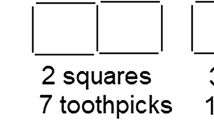Abstract
In this paper, we describe a one-day professional development activity for mathematics teachers that promoted the use of comparison as an instructional tool to develop students’ flexibility in algebra. Effective use of comparison in mathematics instruction involves using side-by-side presentation of problems and solution methods and subsequent student discussion of these multiple solution methods to highlight the similarities and differences among problem-solving techniques. The goals of the professional development activity were to make teachers aware of how to use comparison effectively in their instruction, as well as to impact teachers’ own flexibility in algebra by using comparison instructionally during the professional development. Our analysis of teachers’ experiences in the professional development activity suggests that when teachers were presented with techniques for effective use of comparison, their own understanding of multiple solution methods was reinforced. In addition, teachers began to question why they relied exclusively on one familiar method over others that are equally effective and perhaps more efficient and started to draw new connections between problem-solving methods. Finally, as a result of experiencing instructional use of comparison, teachers began to see value in teaching for flexibility and reported changing their own teaching practices.



Similar content being viewed by others
References
Berk, D., Taber, S., Gorowara, C., & Poetzl, C. (2009). Developing prospective elementary teachers’ flexibility in the domain of proportional reasoning. Mathematical Thinking and Learning, 11, 113–135.
Fennema, E., Carpenter, T. P., Franke, M. L., Levi, L., Jacobs, V. R., & Empson, S. B. (1996). A longitudinal study of learning to use children’s thinking in mathematics instruction. Journal for Research in Mathematics Education, 27, 403–434.
National Council of Teachers of Mathematics. (2006). Curriculum Focal Points for prekindergarten through grade 8 mathematics: A quest for coherence. Reston, VA: Author.
National Mathematics Advisory Panel. (2008). Foundations for success: The final report of the National Mathematics Advisory Panel. Washington, DC: U.S. Department of Education.
National Research Council. (2000). How people learn: Brain, mind, experience, and school. Washington, DC: National Academy Press.
National Research Council. (2001). Adding it up: Helping children learn mathematics. Washington, DC: National Academy Press.
Newton, K. J. (2008). An extensive analysis of elementary preservice teachers’ knowledge of fractions. American Educational Research Journal, 45(4), 1080–1110.
Rittle-Johnson, B., & Star, J. R. (2007). Does comparing solution methods facilitate conceptual and procedural knowledge? An experimental study on learning to solve equations. Journal of Educational Psychology, 99(3), 561–574.
Silver, E. A., Ghousseini, H., Gosen, D., Charalambous, C., & Strawhun, B. (2005). Moving from rhetoric to praxis: Issues faced by teachers in having students consider multiple solutions for problems in the mathematics classroom. Journal of Mathematical Behavior, 24, 287–301.
Star, J. R. (2005). Reconceptualizing procedural knowledge. Journal for Research in Mathematics Education, 36(5), 404–411.
Star, J. R. (2007). Foregrounding procedural knowledge. Journal for Research in Mathematics Education, 38(2), 132–135.
Star, J. R., & Rittle-Johnson, B. (2008). Flexibility in problem solving: The case of equation solving. Learning and Instruction, 18, 565–579.
Star, J. R., & Seifert, C. (2006). The development of flexibility in equation solving. Contemporary Educational Psychology, 31, 280–300.
Verschaffel, L., Luwel, K., Torbeyns, J., & van Dooren, W. (2009). Conceptualizing, investigating, and enhancing adaptive expertise in elementary mathematics education. European Journal of Psychology of Education, 24(3), 335–359.
Zaslavsky, O., & Leikin, R. (2004). Professional development of mathematics teacher educators: Growth through practice. Journal of Mathematics Teacher Education, 7(1), 5–32.
Author information
Authors and Affiliations
Corresponding author
Rights and permissions
About this article
Cite this article
Yakes, C., Star, J.R. Using comparison to develop flexibility for teaching algebra. J Math Teacher Educ 14, 175–191 (2011). https://doi.org/10.1007/s10857-009-9131-2
Published:
Issue Date:
DOI: https://doi.org/10.1007/s10857-009-9131-2




